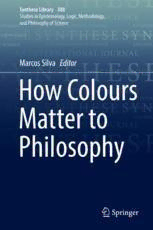
How Colours Matter to Philosophy PDF
Preview How Colours Matter to Philosophy
Synthese Library 388 Studies in Epistemology, Logic, Methodology, and Philosophy of Science Marcos Silva Editor How Colours Matter to Philosophy Synthese Library Studies in Epistemology, Logic, Methodology, and Philosophy of Science Volume 388 Editor-in-Chief OtávioBueno,UniversityofMiami,DepartmentofPhilosophy,USA Editors BeritBrogaard,UniversityofMiami,USA AnjanChakravartty,UniversityofNotreDame,USA StevenFrench,UniversityofLeeds,UK CatarinaDutilhNovaes,UniversityofGroningen,TheNetherlands The aim of Synthese Library is to provide a forum for the best current work in themethodologyandphilosophyofscienceandinepistemology.Awidevarietyof different approaches have traditionally been represented in the Library, and every effortismadetomaintainthisvariety,notforitsownsake,butbecausewebelieve thattherearemanyfruitfulandilluminatingapproachestothephilosophyofscience andrelateddisciplines. Specialattentionispaidtomethodologicalstudieswhichillustratetheinterplay of empirical and philosophical viewpoints and to contributions to the formal (logical,set-theoretical,mathematical,information-theoretical,decision-theoretical, etc.) methodology of empirical sciences. Likewise, the applications of logical methodstoepistemologyaswellasphilosophicallyandmethodologicallyrelevant studiesinlogicarestronglyencouraged.Theemphasisonlogicwillbetemperedby interestinthepsychological,historical,andsociologicalaspectsofscience. BesidesmonographsSyntheseLibrarypublishesthematicallyunifiedanthologies and edited volumes with a well-defined topical focus inside the aim and scope of the book series. The contributions in the volumes are expected to be focused and structurally organized in accordance with the central theme(s), and should be tied togetherbyanextensiveeditorialintroductionorsetofintroductionsifthevolume isdividedintoparts.Anextensivebibliographyandindexaremandatory. Moreinformationaboutthisseriesathttp://www.springer.com/series/6607 Marcos Silva Editor How Colours Matter to Philosophy 123 Editor MarcosSilva FederalUniversityofAlagoas Maceió,Alagoas,Brazil SyntheseLibrary ISBN978-3-319-67397-4 ISBN978-3-319-67398-1 (eBook) DOI10.1007/978-3-319-67398-1 LibraryofCongressControlNumber:2017957065 ©SpringerInternationalPublishingAG2017 Thisworkissubjecttocopyright.AllrightsarereservedbythePublisher,whetherthewholeorpartof thematerialisconcerned,specificallytherightsoftranslation,reprinting,reuseofillustrations,recitation, broadcasting,reproductiononmicrofilmsorinanyotherphysicalway,andtransmissionorinformation storageandretrieval,electronicadaptation,computersoftware,orbysimilarordissimilarmethodology nowknownorhereafterdeveloped. Theuseofgeneraldescriptivenames,registerednames,trademarks,servicemarks,etc.inthispublication doesnotimply,evenintheabsenceofaspecificstatement,thatsuchnamesareexemptfromtherelevant protectivelawsandregulationsandthereforefreeforgeneraluse. Thepublisher,theauthorsandtheeditorsaresafetoassumethattheadviceandinformationinthisbook arebelievedtobetrueandaccurateatthedateofpublication.Neitherthepublishernortheauthorsor theeditorsgiveawarranty,expressorimplied,withrespecttothematerialcontainedhereinorforany errorsoromissionsthatmayhavebeenmade.Thepublisherremainsneutralwithregardtojurisdictional claimsinpublishedmapsandinstitutionalaffiliations. Printedonacid-freepaper ThisSpringerimprintispublishedbySpringerNature TheregisteredcompanyisSpringerInternationalPublishingAG Theregisteredcompanyaddressis:Gewerbestrasse11,6330Cham,Switzerland Endorsements Questionsaboutthenatureofcolour–howandwhatweknowaboutthem;howwe experience them; how they fit into nature – grip the philosophical imagination as much today as they have done down the ages. This outstanding volume collectstogetherscholarswithadeepunderstandingofthehistoryoflongstanding epistemological and metaphysical puzzles and the history of debates associated withcolour.Yetitdoesmuchmore,itsaddressesagapinthemarket,byrevealing howlearninglessonsfromboththeanalyticandcontinentalphilosophicaltraditions canbearfruitinourthinkingaboutcolour.Morethanthat,thecollectionshowcases how new research about the nature of colour figures can inform and be informed by new thinking about language, mind, phenomenology, aesthetics, logic and mathematics. Its chapters make clear why questions they examine matter to those working in fields and disciplines outside of philosophy. In achieving all of this, thisbookbeautifullypreparesthegroundforthenextstepsinourresearchonand philosophisingaboutcolour. Daniel D. Hutto is Professor of Philosophical Psychology at the University of Wollongong,Australia ItisnotanoverstatementtosaythatHowColoursMattertoPhilosophyisaground- breaking publication. It is the first edited volume on the philosophy of colour to reach far beyond the core topics of metaphysics, epistemology and naturalistic philosophy ofmind,bringingwithinitspurviewlogic,philosophy ofmathematics andaesthetics.Therearealsoimportantcontributionstotheliteratureonrelatively under-explored historical topics, such as Wittgenstein’s theory of colour and Goethe’s philosophy of the scientific method. The entries are methodologically sophisticatedandphilosophicallyrewarding,andIexpectthatmanyofthemwillbe the starting point for future scholarly debates. The volume is essential reading for advancedstudentsandresearchersseekingnewperspectivesonaperennialissuein systematicphilosophy. MazviitaChirimuutaisAssociateProfessor,History&PhilosophyofScienceat theUniversityofPittsburgh,USA v vi Endorsements The book assembles an impressive variety of contributions from different theoret- ical approaches and philosophical traditions. The puzzling nature of colours, its central common theme, unites chapters touching on a great number of domains (philosophy of mind, philosophy of language, metaphysics, logic, philosophy of science and history of philosophy). This diverse collection has the potential to seduce readers into getting to know research areas they would otherwise have ignored. It contains a number of rigorously argued and yet accessible original papers. Anyone interested in philosophical issues about colour will find it highly stimulating. Martine Nida-Rümelin is Philosophy Professor at the Université de Fribourg, Switzerland Colour has intrigued and puzzled scientists and philosophers since antiquity. Nowadays, the philosophy of colour is a highly active subfield in analytic phi- losophy. While acknowledging the contemporary discussions and often directly contributing to them, this collection of papers aims to also approach the philos- ophy of colour from less well-travelled paths. Thus detailed attention is paid to the history of thinking about colour, to phenomenology and mathematics, and not all of this book’s authors take naturalism, or the standard forms of it, for granted. The high-quality papers included in this anthology succeed admirably in enriching current philosophical thinking about colour. The reader will find refreshing treatments of familiar problems and will be guided to neglected and novel philosophical questions that the elusive phenomenon of colour continues topose. ErikMyinisProfessorofPhilosophyattheUniversityofAntwerp,Belgium This is certainly the most complete collection of philosophical essays on colours everpublished.Thoseinterestedinthehistoryoftheproblemsinceantiquityorin thefamousdebateopposingNewtonandGoethewillfindherenewinterpretations. But there is much more. Colours can be approached from many different points of view: logico-linguistic, phenomenological, aesthetic or metaphysical. It is hard to believe that all these approaches can find their place in one single book. This is Marcos Silva’s feat: for years, he worked hard and patiently to gather all these essays and organized them by topics. The result is astonishing: what makes our sensorial experiences so rich and lively is here, at least in part, deciphered. If not all the philosophical enigmas associated with colours are resolved, this collection of original and up-to-date essays is no doubt an important step in the rightdirection. AndréLeclercisProfessorofPhilosophyattheUniversityofBrasília,Brazil This outstanding volume merges eighteen excellent paradigms of showing how coloursandtheirexpressionsmattertophilosophy.Transcendingtraditionalbound- aries authors from twelve countries combine aspects of metaphysics, history of philosophy, epistemology, philosophy of mind, aesthetics, psychology, lin- guistics, logic and mathematics in a very inspiring manner. Anyone who is interested in philosophical investigations on colours can learn a lot starting with Endorsements vii the ancient Greeks, continuing with Goethe, Newton, Husserl, Katz, Bühler, Heidegger, Wittgenstein and ending up with advanced studies in the contexts of vagueness, cognition and the four-colour theorem. All in all, this collection represents a new milestone in the ongoing philosophical debate on colours and colourexpressions. Ingolf Max is Professor of Analytic Philosophy at the University of Leipzig, Germany Contents PartI HistoryofPhilosophy Dispositionalism:DemocritusandColoursbyConvention.................. 3 BarryMaund Hue,Brightness&SaturationinClassicalGreekChromaTerms ......... 25 EkaiTxapartegi HowManyColours?............................................................. 47 KirstenWalsh GoethecontraNewtononColours,Light,andthePhilosophy ofScience.......................................................................... 73 OlafL.Müller OnColor:TheHusserlianMaterialaPriori.................................. 97 JairoJoséda Silva ImpossibleColours:WittgensteinandtheNaturalist’sChallenge ......... 107 AndrewLugg PartII PhenomenologyandPhilosophyofMind Colours–Wittgensteinvs(Katz&Bühler)................................... 125 KevinMulligan WhattheMind-IndependenceofColorRequires ............................ 137 PeterW.Ross ExplainingColourPhenomenology............................................ 159 NicholasUnwin DaseinIstheAnimalThatSortsOutColors.................................. 175 BernardoAinbinder ix x Contents SubjectivityandNormativityinColour-Distinctions ........................ 195 PirminStekeler-Weithofer Colors:PresentationandRepresentationintheFineArts.................. 215 OtávioBueno PartIII PhilosophyofLanguageandPhilosophyofLogic ThingsAreNotWhatTheySeem .............................................. 225 GrahamPriest Vagueness,Hysteresis,andtheInstabilityofColor .......................... 237 DianaRaffman LogicandColourinCognition,LogicandPhilosophy ...................... 249 DanyJaspers AChromaticHexagonofPsychicDispositions ............................... 273 Jean-YvesBeziau ProofsVersusExperiments:WittgensteinianThemesSurrounding theFour-ColorTheorem ........................................................ 289 GiseleDalvaSeccoandLuizCarlosPereira TheWonderofColorsandthePrincipleofAriadne......................... 309 WalterCarnielliandCarlosdiPrisco NameIndex....................................................................... 319 SubjectIndex..................................................................... 321
